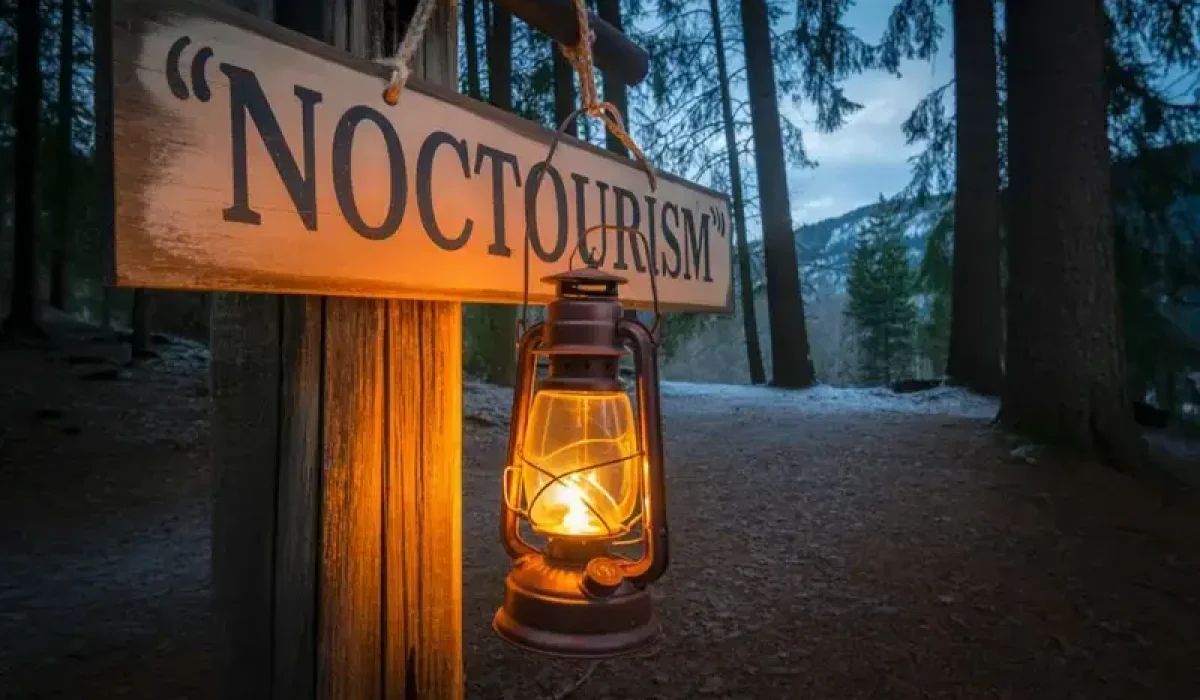Have you ever wondered what the world looks like after going under the sun? Welcome to the attractive realm of nighttime adventures, also known as Noctourism! This growing trend is changing how we detect our surroundings by converting our adventures to hours of evening. Noctourism refers to traveling and searching for destinations, especially during nighttime. This unique form of tourism provides a completely different experience compared to day trips, revealing the hidden dimensions of familiar places.
From stargazing in remote forest areas to the discovery of the streets of a lively city, nighttime adventures open an entirely new world of possibilities for curious travelers. The popularity of night tourism has increased significantly in recent years. More people are searching for the magic that occurs after the darkness, whether it is the peace of nature without the crowd of day or the energetic pulse of urban nightlife.
Travel companies have noticed this trend, especially by creating special tourism experiences designed for night explorers.
Exploring after dark offers several unique benefits:
- Escape daytime heat in warm climates
- Experience less crowded attractions
- Witness phenomena only visible at night (stars, bioluminescence, nocturnal wildlife)
- See familiar places transformed by darkness and artificial lighting
Table of Contents
Benefits of Noctourism
The noctourism offers a crowd of advantages that distinguish it from traditional day tourism. One of the most compelling Benefits is an opportunity to gain a unique approach and experience. By interacting with the environment under Night veils, passengers can see the invisible, subtle details and events during the day. For example, many wildlife species are only active at night, providing opportunities to inspect creatures and behaviors that are rarely seen in the daylight. Other than this, Moonlight and wires modifiy the changes of the sky, transforming the landscape into a magical, almost another scene. Stay etched in memory.
Another major benefit is the tendency of noctourism activities to attract fewer crowds. Popular day destinations often have Crowds and noise, which can separate intimacy and look like many passengers. Night tour usually brings more solitude, allows courageous people to connect deeply with their surroundings and enjoy a rich sensory Experience. This piece also facilitates reflection, mindfulness, and relaxation, contributing positively to mental well-being.
The night also increases sensory perception by increasing sounds, smells, and sights in various ways. Darkness intensifies the senses of hearing and smell, and low light pollution in natural settings allows for spectacular views of the sky, creating a breathtaking visual experience. In an urban environment, night lights and architecture are presented as photogenic, Unavailable during the day.
This sensory growth helps to deepen praise, promotes creativity, and Visitors are often surprised with new dimensions at familiar places.
Types of Nighttime Adventures
Nighttime adventures come in many forms, catering to different interests and comfort levels. Here are some popular categories:
Urban Night Exploration
The city changes after sunset, providing exciting opportunities for night tourism. There is a dramatically burnt architecture, vibrant road performance, and night markets in the urban nitescape. Many cities offer special evening tourism, exposing historical sites, street art, or culinary experiences. Popular urban night adventures include:
- Ghost tourism directed through historical districts
- Night photography captures the city lights
- Sampling of evening meal seizures, local cuisine
- Architectural Illumination Tours
Natural Nocturnal Activities
Nature reveals a different side after dark. Many national parks and nature reserves offer night expeditions that allow visitors to see the natural world during their most active hours. These experiences often focus on:
- Stargazing campaign in minimum light pollution areas
- Spotting owls, bats, and other nocturnal organisms
- Moonlight growth with specially designated trails
- Bioluminous kayaking tours in coastal areas
Cultural Night Tourism Opportunities
Cultural institutions increasingly recognize the appeal of evening hours. Many museums, historical sites, and cultural venues offer special nighttime programming:
- Museum after-dark events featuring special exhibits and performances
- Evening concerts in historical settings
- Night festivals celebrating local traditions and holidays
- Theatrical experiences designed specifically for nighttime settings
Specialized Night Adventure Tours
For thrill-seekers, specialized nighttime adventures offer unique experiences:
- Night skiing on illuminated slopes
- After-dark zip lining through forests
- Evening rock climbing with specialized equipment
- Night diving to witness nocturnal marine life
Safety Considerations for Night Exploration
While nighttime adventures provide unique adventures, they require special safety precautions. Before starting your nocturnal trip, consider these important factors:
Necessary adventure safety equipment
Safety should always be your top priority during nighttime adventures. Major equipment includes:
- High-quality headlamps or flashlights with a backup battery
- Reflective clothes or accessories for visibility
- Complete the charge on your mobile phone with emergency contacts
- Basic first aid kit adapted for evening use
- Whistle or other signaling device
According to the American Hiking Society, proper light is the most important safety idea for hiking and exploration at night.
Planning for Nighttime Adventures
Thorough planning is crucial for successful nocturnal activities:
- Research your destination during daylight hours if possible
- Check closing times and access restrictions
- Inform someone of your plans and expected return time
- Study maps before departing, and bring physical copies
- Check weather forecasts specifically for evening conditions
Group vs. Solo Night Tourism
Night exploration is generally safer in groups. Consider these points:
- Solo adventures increase risk factors, especially in remote areas
- Small groups provide safety in numbers while maintaining an intimate experience
- Guided tours offer expert knowledge and established safety protocols
- Local companions can provide cultural context and navigation assistance
Weather Considerations for Nocturnal Activities
Weather impacts nighttime adventures differently than daytime excursions:
- Temperatures often drop significantly after sunset
- Fog and mist are more common at night
- Wind patterns may change in evening hours
- Precipitation can be harder to detect and navigate
The National Weather Service recommends checking hourly forecasts rather than general daily predictions when planning evening outings.
Best Destinations for Noctourism
Some places truly shine after dark, making them ideal for nighttime adventures:
Urban Centers Known for Night Exploration
Cities with vibrant nightlife and illumination strategies offer excellent night tourism opportunities:
- Tokyo, Japan: famous for neon districts and evening technology exhibitions
- New Orleans, USA: renowned for ghost tours and evening jazz performances
- Barcelona, Spain: features illuminated Gaudí architecture and evening tapas culture
- Melbourne, Australia, offers extensive night markets and evening art installations
Natural Settings Ideal for Nighttime Adventures
Some natural environments provide exceptional nocturnal experiences:
- Puerto Rico’s Mosquito Bay: world-famous bioluminescent bay perfect for evening kayaking.
- Joshua Tree National Park (USA): exceptional stargazing and night photography
- Costa Rican rainforests: guided night walks to spot unique nocturnal wildlife.
- Norway’s northern regions: ideal for viewing the Northern Lights.
Dark Sky Reserves for Astronomical Experiences
For serious stargazers, International Dark Sky Reserves offer unparalleled viewing:
- NamibRand Nature Reserve, Namibia
- Aoraki Mackenzie (New Zealand)
- Mont-Mégantic (Canada)
- Exmoor National Park (UK)
According to the International Dark-Sky Association, these designated areas maintain strict light pollution controls to preserve natural darkness.
Equipment and Preparation
Lighting Requirements for Adventure Safety
Quality lighting is non-negotiable for night exploration:
- Headlamps leave hands free for activities and navigation
- Red light options preserve night vision for stargazing
- Consider lighting brightness measured in lumens (150-300 lumens is sufficient for most activities)
- Backup light sources prevent being stranded in the darkness
Appropriate Clothing for Night Tourism
Dressing properly for nocturnal activities requires special consideration:
- Layer clothing to adjust for dropping temperatures
- Choose moisture-wicking fabrics that retain warmth when damp
- Wear bright or reflective outer layers for visibility
- Pack additional warm layers even on seemingly mild evenings
Navigation Tools for Nighttime Adventures.
Finding your way in the darkness requires reliable tools:
- GPS devices with backlit screens
- Compass and physical maps as backup
- Mobile apps designed specifically for night navigation
- Familiarity with landmarks visible after dark
Environmental and Cultural Considerations
Responsible night tourism requires respecting both nature and local communities:
Minimizing Disturbance During Night Exploration
Nighttime environments are particularly sensitive to human presence:
- Use minimal, directed lighting.
- Stay on designated paths to avoid damaging unseen vegetation
- Keep noise levels low as sound travels differently at night
- Take all trash with you, as it’s easier to litter in the darkness accidentally
Respecting Wildlife During Nocturnal Activities
Many animals are active primarily at night:
- Avoid using bright white lights directly on wildlife
- Maintain distance from nocturnal animals
- Never feed wildlife encountered during evening hours
- Learn to recognize signs of animal distress.
The National Park Service offers guidelines for ethical wildlife viewing that are especially important during nighttime adventures.
Cultural Sensitivity in Night Tourism
Different cultures have varying relationships with nighttime activities:
- Research local customs regarding evening activities
- Respect quiet hours in residential areas
- Understand the cultural significance of certain nocturnal festivities
- Follow local guidance about restricted areas after dark
Conclusion
The Nighttime adventures offer extraordinary opportunities to experience places familiar with new ways. Whether you are ready for the twinkling lights of the urban landscape or the intense darkness of the forest, the Nokturism provides a unique approach and memorable experience. As this form of tourism increases, we can expect more special offerings for night explorers. Communities centered around specific nocturnal activities are emerging, attracting daring people with similar ideologies and sharing special knowledge.
Perhaps most importantly, night discovery often leads to personal development. Awareness needs to increase to navigate the darkness, create confidence, and make deep relations with our surroundings. Many night tourists report that evening experiences feel more intense and memorable than their day counterparts. Are you ready to start your own nighttime adventures? Start small with a guided evening attack in your local area, gently build skills and confidence for more ambitious nocturnal explores.
Prioritize security, respect your environment, and embrace the unique magic that exists only after sunset. The demand for “noctourism” continues to grow, so, which night adventure will you start for the first time?




